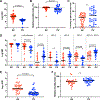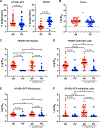Antibody binding to native cytomegalovirus glycoprotein B predicts efficacy of the gB/MF59 vaccine in humans
- PMID: 33148624
- PMCID: PMC8058742
- DOI: 10.1126/scitranslmed.abb3611
Antibody binding to native cytomegalovirus glycoprotein B predicts efficacy of the gB/MF59 vaccine in humans
Abstract
Human cytomegalovirus (CMV) is the most common infectious cause of infant brain damage and posttransplant complications worldwide. Despite the high global burden of disease, vaccine development to prevent infection remains hampered by challenges in generating protective immunity. The most efficacious CMV vaccine candidate tested to date is a soluble glycoprotein B (gB) subunit vaccine with MF59 adjuvant (gB/MF59), which achieved 50% protection in multiple historical phase 2 clinical trials. The vaccine-elicited immune responses that conferred this protection have remained unclear. We investigated the humoral immune correlates of protection from CMV acquisition in populations of CMV-seronegative adolescent and postpartum women who received the gB/MF59 vaccine. We found that gB/MF59 immunization elicited distinct CMV-specific immunoglobulin G (IgG)-binding profiles and IgG-mediated functional responses in adolescent and postpartum vaccinees, with heterologous CMV strain neutralization observed primarily in adolescent vaccinees. Using penalized multiple logistic regression analysis, we determined that protection against primary CMV infection in both cohorts was associated with serum IgG binding to gB present on a cell surface but not binding to the soluble vaccine antigen, suggesting that IgG binding to cell-associated gB is an immune correlate of vaccine efficacy. Supporting this, we identified gB-specific monoclonal antibodies that differentially recognized soluble or cell-associated gB, revealing that there are structural differences in cell-associated and soluble gB are relevant to the generation of protective immunity. Our results highlight the importance of the native, cell-associated gB conformation in future CMV vaccine design.
Copyright © 2020 The Authors, some rights reserved; exclusive licensee American Association for the Advancement of Science. No claim to original U.S. Government Works.
Conflict of interest statement
Figures







Similar articles
-
Human Cytomegalovirus Glycoprotein B Nucleoside-Modified mRNA Vaccine Elicits Antibody Responses with Greater Durability and Breadth than MF59-Adjuvanted gB Protein Immunization.J Virol. 2020 Apr 16;94(9):e00186-20. doi: 10.1128/JVI.00186-20. Print 2020 Apr 16. J Virol. 2020. PMID: 32051265 Free PMC article.
-
HCMV glycoprotein B subunit vaccine efficacy mediated by nonneutralizing antibody effector functions.Proc Natl Acad Sci U S A. 2018 Jun 12;115(24):6267-6272. doi: 10.1073/pnas.1800177115. Epub 2018 Apr 30. Proc Natl Acad Sci U S A. 2018. PMID: 29712861 Free PMC article. Clinical Trial.
-
Human Cytomegalovirus mRNA-1647 Vaccine Candidate Elicits Potent and Broad Neutralization and Higher Antibody-Dependent Cellular Cytotoxicity Responses Than the gB/MF59 Vaccine.J Infect Dis. 2024 Aug 16;230(2):455-466. doi: 10.1093/infdis/jiad593. J Infect Dis. 2024. PMID: 38324766
-
Development of a cytomegalovirus vaccine: lessons from recent clinical trials.Expert Opin Biol Ther. 2001 May;1(3):401-12. doi: 10.1517/14712598.1.3.401. Expert Opin Biol Ther. 2001. PMID: 11727514 Review.
-
Development and evidence for efficacy of CMV glycoprotein B vaccine with MF59 adjuvant.J Clin Virol. 2009 Dec;46 Suppl 4(Suppl 4):S73-6. doi: 10.1016/j.jcv.2009.07.002. Epub 2009 Jul 31. J Clin Virol. 2009. PMID: 19647480 Free PMC article. Review.
Cited by
-
Maternal vaccination: a review of current evidence and recommendations.Am J Obstet Gynecol. 2022 Apr;226(4):459-474. doi: 10.1016/j.ajog.2021.10.041. Epub 2021 Nov 11. Am J Obstet Gynecol. 2022. PMID: 34774821 Free PMC article. Review.
-
An insect cell-derived extracellular vesicle-based gB vaccine elicits robust adaptive immune responses against Epstein-Barr virus.Sci China Life Sci. 2024 Oct 31. doi: 10.1007/s11427-023-2599-1. Online ahead of print. Sci China Life Sci. 2024. PMID: 39499444
-
The cytomegalovirus gB/MF59 vaccine candidate induces antibodies against an antigenic domain controlling cell-to-cell spread.Nat Commun. 2023 Feb 23;14(1):1041. doi: 10.1038/s41467-023-36683-x. Nat Commun. 2023. PMID: 36823200 Free PMC article.
-
A conditionally replication-defective cytomegalovirus vaccine elicits potent and diverse functional monoclonal antibodies in a phase I clinical trial.NPJ Vaccines. 2021 Jun 2;6(1):79. doi: 10.1038/s41541-021-00342-3. NPJ Vaccines. 2021. PMID: 34078915 Free PMC article.
-
Vaccination with a replication-defective cytomegalovirus vaccine elicits a glycoprotein B-specific monoclonal antibody repertoire distinct from natural infection.NPJ Vaccines. 2023 Oct 10;8(1):154. doi: 10.1038/s41541-023-00749-0. NPJ Vaccines. 2023. PMID: 37816743 Free PMC article.
References
-
- Fowler KB et al., The outcome of congenital cytomegalovirus infection in relation to maternal antibody status. N Engl J Med 326, 663–667 (1992). - PubMed
-
- Boppana SB, Pass RF, Britt WJ, Stagno S, Alford CA, Symptomatic congenital cytomegalovirus infection: neonatal morbidity and mortality. Pediatr Infect Dis J 11, 93–99 (1992). - PubMed
Publication types
MeSH terms
Substances
Grants and funding
LinkOut - more resources
Full Text Sources
Other Literature Sources

